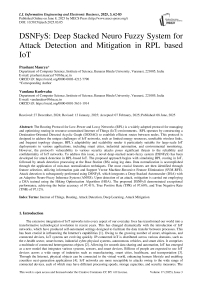DSNFyS: Deep Stacked Neuro Fuzzy System for Attack Detection and Mitigation in RPL based IoT
Автор: Prashant Maurya, Vandana Kushwaha
Журнал: International Journal of Information Engineering and Electronic Business @ijieeb
Статья в выпуске: 3 vol.17, 2025 года.
Бесплатный доступ
The Routing Protocol for Low-Power and Lossy Networks (RPL) is a widely adopted protocol for managing and optimizing routing in resource-constrained Internet of Things (IoT) environments. RPL operates by constructing a Destination-Oriented Directed Acyclic Graph (DODAG) to establish efficient routes between nodes. This protocol is designed to address the unique challenges of IoT networks, such as limited energy resources, unreliable wireless links, and frequent topology changes. RPL's adaptability and scalability render it particularly suitable for large-scale IoT deployments in various applications, including smart cities, industrial automation, and environmental monitoring. However, the protocol's vulnerability to various security attacks poses significant threats to the reliability and confidentiality of IoT networks. To address this issue, a novel deep-stacked neuro-fuzzy system (DSNFyS) has been developed for attack detection in RPL-based IoT. The proposed approach begins with simulating RPL routing in IoT, followed by attack detection processing at the Base Station (BS) using log data. Data normalization is accomplished through the application of min-max normalization techniques. The most crucial features are then identified through feature selection, utilizing information gain and Support Vector Machine-Recursive Feature Elimination (SVM-RFE). Attack detection is subsequently performed using DSNFyS, which integrates a Deep Stacked Autoencoder (DSA) with an Adaptive Neuro-Fuzzy Inference System (ANFIS). Upon detection of an attack, mitigation is carried out employing a DSA trained using the Hiking Optimization Algorithm (HOA). The proposed DSNFyS demonstrated exceptional performance, achieving the better accuracy of 97.41%, True Positive Rate (TPR) of 97.60%, and True Negative Rate (TNR) of 97.12%.
Internet of Things, Routing, Attack Detection, Deep Learning, Attack Mitigation
Короткий адрес: https://sciup.org/15019747
IDR: 15019747 | DOI: 10.5815/ijieeb.2025.03.05


